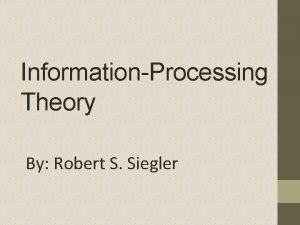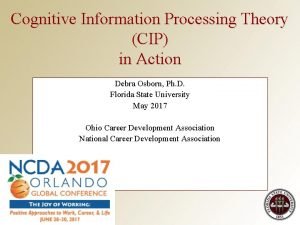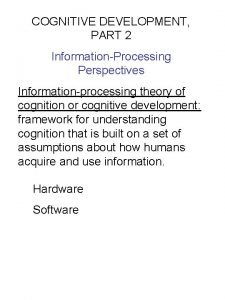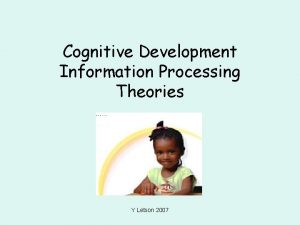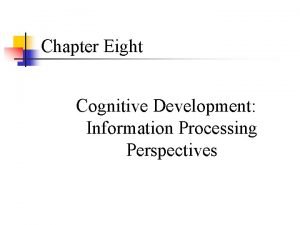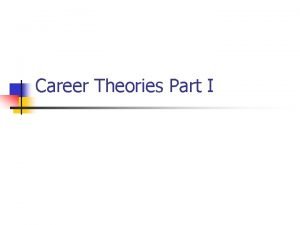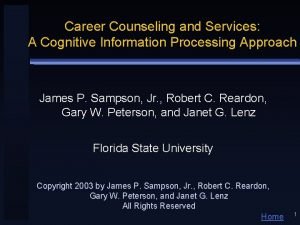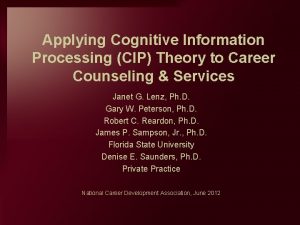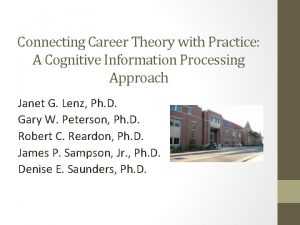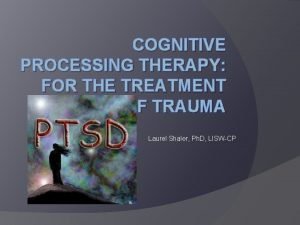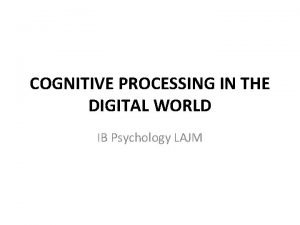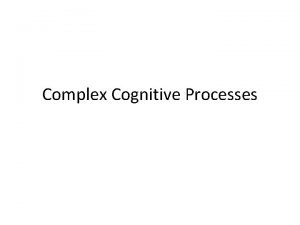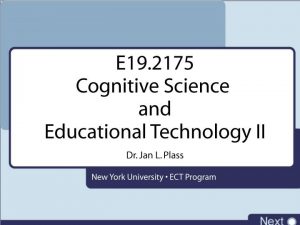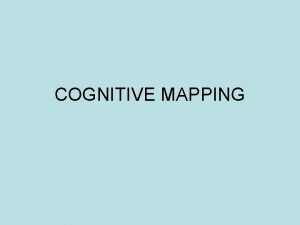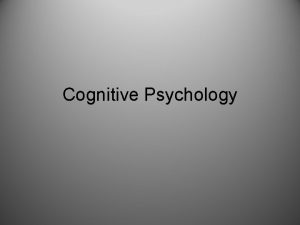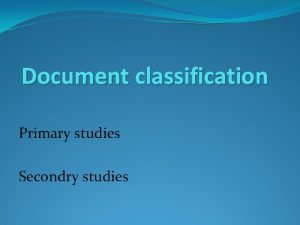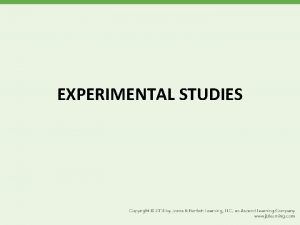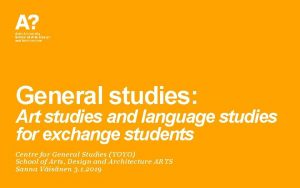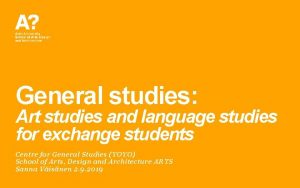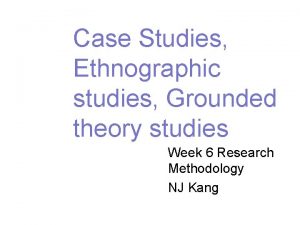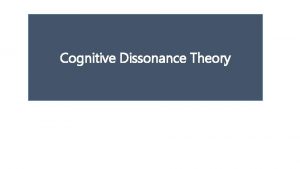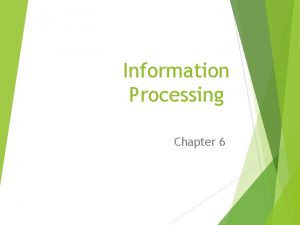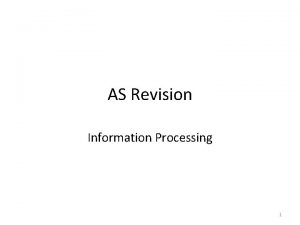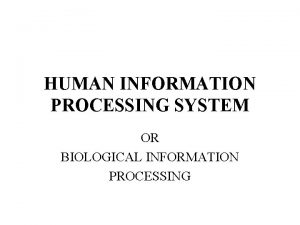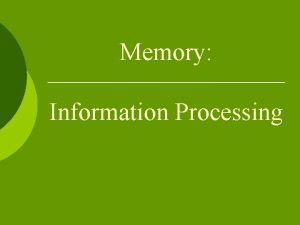Cognitive information processing Cognitive information processing studies the






























































- Slides: 62

Cognitive information processing


• Cognitive information processing studies the internal mental processes involved in the capture and manipulation of information, the use of information to solve problems, and the processes and structures involved in these actions.

Development of CIP • • Research on memory Development of networking concepts Development of computers Development of information theory • By the 1960 s, a significant number of researchers were studying cognitive phenomena • By the 1970 s and early 80 s the cognitive revolution had changed psychology as a discipline

Issues • How is ‘information’ in the environment scanned? • What leads to further processing? • How is information included in memory? • How is information recalled from memory? • How is information used in later thinking/action?

Some general rules • • Environmental input is massive and continual Cognitive capacity is limited Much cognitive functioning can be automated Satisficing rules are applied to deal with the flow of information and to generate effective actions and knowledge – Selectivity

Some general rules • A form of control is necessary to make decisions on what to attend to, how to process important information, what decision rules to apply in Working Memory, etc. • Control of both automatic and ‘willful’ types – Automatic control resides in “lower” brain – Control functions the individual can ‘decide’ to use reside in the ‘more advanced’ parts of the brain

General principles • Control mechanism – Allocates processing capacity – Prioritizes activities – Coordinates actions


To begin • Sense organs are excited by environmental stimuli • The stimuli are ‘transduced’ into signals (electrical) that can be carried in the neural pathways

Sensory activation – Environmental cues generate changes within specialized organs • • Eyes Ears Skin Tongue – Only a portion of environmental phenomena generate sensual changes • Infrared light • X-rays

http: //www. google. com/imgres? imgurl=http: //gapyx. com/cmt/2007/02/anatomy 3. jpg&imgrefurl=http: //cha mbermusictoday. blogspot. com/2007/02/stapedius-spasms-mixed-boonbane. html&usg=__HXPFgr. FEKd 7 WK 9 OYWJ 7 Ypdj_o. Dk=&h=317&w=540&sz=21&hl=en&start=0&zoom=1&tbn id=52 so. Rbl. U 1 DGj. SM: &tbnh=112&tbnw=190&ei=o 15 ITaq. BJo_vc. MKX 1 Jw. D&prev=/images%3 Fq%3 Daudible% 2 Bsound%26 hl%3 Den%26 biw%3 D 1268%26 bih%3 D 598%26 gbv%3 D 2%26 tbs%3 Disch: 1&itbs=1&iact=hc&vpx= 125&vpy=101&dur=481&hovh=160&hovw=273&tx=160&ty=94&oei=ll 1 ITef_M 8 f. Kg. Qe 0 JTs. BQ&esq=14&page=1&ndsp=18&ved=1 t: 429, r: 0, s: 0

Limitations • There are very significant limits as to what stimuli can be perceived via human sense organs – Visible spectrum of light – Audible sounds – Haptic limitations

http: //www. google. com/imgres? imgurl=http: //chemed. chem. purdue. edu/genchem/topicreview/bp/ch 6/graphics/spectrum. gif&imgrefurl=http: //chemed. chem. p urdue. edu/genchem/topicreview/bp/ch 6/index. php&usg=__RNcg. Hr. E 5 jv 51 jmg 9 nst-d. Gsvj 8=&h=319&w=599&sz=23&hl=en&start=0&zoom=1&tbnid=cy. EKfi. Tapbz 5 OM: &tbnh=108&tbnw=202&ei=CF 1 ITc. XQMMf 1 g. Af. J 28 zo. BQ&prev=/images%3 Fq%3 Dv isible%2 Bspectrum%2 Bof%2 Blight%26 hl%3 Den%26 biw%3 D 1268%26 bih%3 D 598%26 gbv%3 D 2%26 tbs%3 Disch: 1&itbs=1&iact=hc&vpx=337&vpy=285&dur=1149&ho vh=108&hovw=202&tx=159&ty=75&oei=CF 1 ITc. XQMMf 1 g. Af. J 28 zo. BQ&esq=1&page=1&ndsp=15&ved=1 t: 429, r: 6, s: 0


Transduction of sensual reaction • Sensory organs create patterns of electrical impulses as a response to environmental stimuli – (Transduction) • Qualitatively different patterns are produced for visual, sound, touch (haptic), and language (semantic) memory systems


Buffering and filtering • Sensual buffers are thought to exist that retain the electrical impulses for a short period of time • The ‘most important’ content is passed along while the ‘less important’ content is filtered out • Cannot handle the vast amount of information that senses generate • Filtering is based on ‘pattern recognition’




Attention • Recognition of content of various types leads to the allocation of processing capacity—the physical component of attention – Limited resource – Influenced by a number of factors, some contentbased, some ‘feature’ based – Much attention is allocated “automatically” and not under the control of the individual

http: //assets. families. com/Encyclopedias/eoa_01_img 0077. jpg

Determinants of attention • Most content is disposed of quickly— recognized as routine and then ignored – “Habituation” of repetitive tasks, experiences leads to ‘monitoring’ – Attention allocated to divergence from the norm, expectations

Determinants of attention • Hard-wired to attend to cues that had survival value (those that didn’t left the gene pool) • “Orienting response” due to – Movement – Loud noises – Bright colors/contrasts

Formal features • All media content has certain ‘formal features’ that impact the experience the audience has when watching, reading, listening to the content – Formal features are not specific to a story line, genre, etc. • Brightness, pacing, color intensity, cuts, camera angles, and so on

• Overuse of volume change, sudden movement, etc. can impede encoding • Processing capacity tied up interpreting formal features – overloading can lead to confusion, inadequate time for building memory trace or schematization • What topics did you just see? What animals? • Overuse may be annoying so that the audience member may quit attending or switch channel, etc.

Learned automaticity • Some kinds of content are “overlearned’’ to the point where the viewer processes them without thinking about it—so well-known that they do not command precious processing capacity – Driving well-known routes – Listening to favorite CDs – Walking across campus – Greetings for good friends – Your name—“Cocktail party phenomenon”

Personal relevance/Involvement • Impact on you or those you care about – News • Relationship to your values/morals – Note: the way something is presented may determine whether it is interpreted as relevant or not

Determinants of attention • Internally-generated needs draw attention to content perceived to relate to those needs – Hunger – Pain – Fear – Sexual desire

Controlled attention • “Intentional” focus on particular content – Recognized as interesting or important • Emotionally compelling (relatively automatic) • Cognitively challenging (relatively intentional) • Personally impactful/“Involving” – Based on existing schema developed over time by the audience member

Individual interest • Experience with place/time depicted • Mystery stories set in your home town – Fargo • Feelings toward actors, spokespeople, etc. • Trust • Parasocial interaction • Experience with various types of content • Background makes it possible to limit attention necessary to process the content • Genre knowledge and preference • Taste development • News habit

Working and Short-Term Memory • For further processing to occur, the information must be held in memory long enough to compare the information with existing knowledge • Relationship between STM and WM is controversial


Capacity of STM • Often considered “ 7+/-2 chunks” of information • More recent research has argued that we have greater capacity – Ability to monitor many environmental cues at one time, shift attentional resources as needed

Working memory • The active portion of memory (including consciousness) where processes reject, evaluate, interpret information – Where “consciousness” lies • Thought to hold info for 15 -30 seconds unless rehearsal occurs – Decay/displacement • Repetitive v. elaborative rehearsal

Rehearsal/Encoding • Decisions must be made as to what information within WM will receive the processing effort (attention) necessary to encode it for storage • The chosen portion is prepared for transfer to LTM (“encoding”) • When transferred, a “memory trace” must be constructed in order to find it again

Distraction • If memory traces are not laid down prior to shift in cognitive focus, the content being evaluated is probably lost

Working memory • Must activate stored material in LTM to assign meaning to the new patterns of electrical impulses – What does “economic impact” (a pattern of impulses representing a set of characters on a page) mean?







Long-Term Memory • A small portion of ‘information’ from working memory is prepared for transfer to long-term (permanent) storage – To do so, it is integrated into structures of meaning (schema) held within long-term memory – The integration gives ‘meaning’ to the new information while reconfiguring the schema that are activated to interpret the new info • Reconfiguration of schema is usually minor

• The portion of schema activated depends on attention allocation, nature of new information

Retrieval from LTM • Information retrieved from LTM is limited – Would quickly reach overload if we tried to access all potentially relevant info – Would take far too long—can’t spend long periods of time on anything but the most crucial new info/decision-making • Retrieval based on perceived shared or similar meaning/concepts – Memories in LTM organized hierarchically? Schematically? Etc.

Influences on retrieval • Primacy – Earliest concepts draw info from particular parts of schema/schemas • Recency – Recently activated concepts more likely to be retrieved • Commonly used concepts – Concepts/schemas heavily used tend to be activated to deal with new concepts

Influences on retrieval • Concepts are retrieved according to the set of relationships they have with other concepts – Spreading activation • The structure of relationships varies by individual – Culture influences structure of relations/ topics/concepts held




• http: //www. thedailyshow. com/watch/thudecember-14 -2006/confusing-sects • http: //www. funnyordie. com/videos/ed 0 ad 6 a 632/dazed-and-confused

Into LTM • A memory trace to the new information is laid down along with the concepts – More powerful impact of info leads to stronger trace – Trace will fade with time or else be eclipsed by newer traces

Forms of LTM • Episodic LTM – Sounds – Sights • Semantic LTM – Concepts (generalization)

Construction of memory • Belief that more specific concepts are ‘filed’ under more general ones – Efficient

Schema Structure of Semantic LTM • Concepts and the network of associations among them • [Nodes and links]

Out of LTM • Information in WM cues a search for similar into held in LTM – Search is partly under conscious control and part automatic • That info may be excited and the new info is given meaning through its connection to existing knowledge

• When a decision is needed, information search and retrieval generates inputs into decision rules • Action or decision leads to new environmental input that will likely be stored with the original information

Behavior • Behavior is mostly controlled by the outcome of info processing in working memory – Actions taken to meet needs/drives/motivations – Responses to environmental demands

Behavior adjustment • The environmental change observed after behavioral action acts as new information that goes through the info processing system and is encoded into our schema relating to the topic – Perceived success, failure becomes a guide to new action brought on by perceived needs, etc. – Self-regulating model
 Information processing theory child development
Information processing theory child development Cip theory
Cip theory Information processing theory of cognitive development
Information processing theory of cognitive development Information processing theory of cognitive development
Information processing theory of cognitive development Information processing theory by atkinson and shiffrin
Information processing theory by atkinson and shiffrin Cognitive information processing theory
Cognitive information processing theory Pyramid of information processing domains
Pyramid of information processing domains Cip model
Cip model Cognitive information processing pyramid
Cognitive information processing pyramid Paradigm shift from women studies to gender studies
Paradigm shift from women studies to gender studies Cognitive and non cognitive religious language
Cognitive and non cognitive religious language Challenging questions worksheet cpt
Challenging questions worksheet cpt Cognitive processing in the digital world
Cognitive processing in the digital world How do we learn complex processes
How do we learn complex processes Hát kết hợp bộ gõ cơ thể
Hát kết hợp bộ gõ cơ thể Bổ thể
Bổ thể Tỉ lệ cơ thể trẻ em
Tỉ lệ cơ thể trẻ em Chó sói
Chó sói Chụp phim tư thế worms-breton
Chụp phim tư thế worms-breton Hát lên người ơi
Hát lên người ơi Các môn thể thao bắt đầu bằng tiếng nhảy
Các môn thể thao bắt đầu bằng tiếng nhảy Thế nào là hệ số cao nhất
Thế nào là hệ số cao nhất Các châu lục và đại dương trên thế giới
Các châu lục và đại dương trên thế giới Công thức tiính động năng
Công thức tiính động năng Trời xanh đây là của chúng ta thể thơ
Trời xanh đây là của chúng ta thể thơ Mật thư anh em như thể tay chân
Mật thư anh em như thể tay chân Phép trừ bù
Phép trừ bù Phản ứng thế ankan
Phản ứng thế ankan Các châu lục và đại dương trên thế giới
Các châu lục và đại dương trên thế giới Thể thơ truyền thống
Thể thơ truyền thống Quá trình desamine hóa có thể tạo ra
Quá trình desamine hóa có thể tạo ra Một số thể thơ truyền thống
Một số thể thơ truyền thống Cái miệng xinh xinh thế chỉ nói điều hay thôi
Cái miệng xinh xinh thế chỉ nói điều hay thôi Vẽ hình chiếu vuông góc của vật thể sau
Vẽ hình chiếu vuông góc của vật thể sau Nguyên nhân của sự mỏi cơ sinh 8
Nguyên nhân của sự mỏi cơ sinh 8 đặc điểm cơ thể của người tối cổ
đặc điểm cơ thể của người tối cổ V. c c
V. c c Vẽ hình chiếu đứng bằng cạnh của vật thể
Vẽ hình chiếu đứng bằng cạnh của vật thể Vẽ hình chiếu vuông góc của vật thể sau
Vẽ hình chiếu vuông góc của vật thể sau Thẻ vin
Thẻ vin đại từ thay thế
đại từ thay thế điện thế nghỉ
điện thế nghỉ Tư thế ngồi viết
Tư thế ngồi viết Diễn thế sinh thái là
Diễn thế sinh thái là Các loại đột biến cấu trúc nhiễm sắc thể
Các loại đột biến cấu trúc nhiễm sắc thể Số nguyên là gì
Số nguyên là gì Tư thế ngồi viết
Tư thế ngồi viết Lời thề hippocrates
Lời thề hippocrates Thiếu nhi thế giới liên hoan
Thiếu nhi thế giới liên hoan ưu thế lai là gì
ưu thế lai là gì Sự nuôi và dạy con của hổ
Sự nuôi và dạy con của hổ Sự nuôi và dạy con của hươu
Sự nuôi và dạy con của hươu Sơ đồ cơ thể người
Sơ đồ cơ thể người Từ ngữ thể hiện lòng nhân hậu
Từ ngữ thể hiện lòng nhân hậu Thế nào là mạng điện lắp đặt kiểu nổi
Thế nào là mạng điện lắp đặt kiểu nổi Top down procesing
Top down procesing Bottom up processing vs top down processing
Bottom up processing vs top down processing Bottom-up processing example
Bottom-up processing example Unsharp masking matlab
Unsharp masking matlab Example of secondary processing
Example of secondary processing Point processing in digital image processing
Point processing in digital image processing Histogram processing in digital image processing
Histogram processing in digital image processing
